GET Checking the source code of a set of C # /. NET components from Sony / PVS-Studio Blog / Sudo Null IT News FREE

A any of you remember, we recently free a version of the analyzer that supports C # code verification . With the advent of the possibility of analyzing verification of projects written in C #, a rising scope for creativity opens up. An analysis of same of these projects developed by Sony Computer Entertainment (SCEI) testament be discussed in this article.
What was curbed?
Sony Computer Entertainment is a telecasting game keep company, a division of Sony Corporation that specializes in video games and game consoles. This company develops video games, computer hardware and software for PlayStation consoles.

The Authoring Tools Framework (ATF) is a put off of C # /. NET components for nonindustrial tools for Windows. ATF is used by most of SCEI's leading TV game development studios for customised tools. This set of components is used by such studios as Naughty Dog, Guerrilla Games, Quantic Dream. In particular, tools mature using these software components were used to create such famous games as The Shoemaker's last of Us and Killzone. ATF is an open beginning project that is available in the repository along GitHub .
Analysis tool
To analyse the source code, the PVS-Studio static analyser was in use . This tool can check source code written in C / C ++ / C #. From each one diagnostic message is described in contingent in the documentation, which gives examples of incorrect code and slipway to specify it. Many descriptions of diagnostics have a link to the corresponding section of the error database , which contains information just about what errors in substantial projects could be heard using certain diagnostics.

You posterior download and try the analyzer along your (operating room someone else's) project exploitation the join .
Error Examples
unexclusive static void DefaultGiveFeedback(IComDataObject data, GiveFeedbackEventArgs e) { .... if (setDefaultDropDesc &adenosine monophosphate;& (DropImageType)e.Effect != currentType) { if (e.Effect != DragDropEffects.None) { SetDropDescription(data, (DropImageType)e.Upshot, e.Effect.ToString(), null); } else { SetDropDescription(data, (DropImageType)e.Effect, e.Effect.ToString(), null); } .... } } Analyzer Warning: V3004 The 'then' argument is equivalent to the 'else' statement. Atf.Graphical user interface.WinForms.vs2010 DropDescriptionHelper.cs 199
As you can see from the code, regardless of the truth of the condition 'e.Effect! = DragDropEffects.None', the aforesaid method will be called with the same arguments. Not being a programmer who wrote this code, it is sometimes difficult to say how to fix this locate correctly, but I believe no one doubts that something needs to be rigid. What exactly is up to the author of the write in code to decide.
Consider the following code snippet:
public ProgressCompleteEventArgs(Exception progressError, aim progressResult, bool cancelled) { ProgressError = ProgressError; ProgressResult = progressResult; Off = cancelled; } Analyzer Warning: V3005 The 'ProgressError' variable is assigned to itself. Atf.Gui.Wpf.vs2010 StatusService.cs 24
It was understood that when the method acting is called, the properties leave embody assigned the values passed as arguments, close to this the name calling of the properties and parameters differ only in the first letter case. As a result, the 'ProgressError' property is written to itself instead of getting the treasure of the 'progressError' parametric quantity.
Interestingly, this is off the beaten track from an isolated case of disarray betwixt uppercase and small letter letters. In some proven projects, errors of on the button the same type were encountered. On that point is a suspicion that soon we bequeath reveal a new exemplary error pattern inherent in programs transcribed in C #. There is a tendency to initialise properties in a method acting whose parameter names differ from the names of initialized properties exclusively in the first letter case. Equally a result, errors like this ace seem. In the following encrypt lesson, if information technology is not erroneous, it looks at least strange:
public ambiguous Left { get on; set; } public double Height { drive; set; } open void ApplyLayout(XmlReader lecturer) { .... FloatingWindow windowpane = new FloatingWindow( this, reader.ReadSubtree()); .... window.Left = windowpane.Left; window.Summit = window.Top; .... } Analyzer Warnings:
- V3005 The 'window. Left' changeable is assigned to itself. Bureau of Alcohol Tobacco and Firearms.GUI.Wpf.vs2010 DockPanel.atomic number 55 706
- V3005 The 'window.Top' variable is allotted to itself. Atf.Graphical user interface.Wpf.vs2010 DockPanel.cs 707
From the analyser's write in code and warnings, it hind end be seen that the 'Left-wing' and 'Best' properties of the 'windowpane' object are written to themselves. For some cases, this alternative is acceptable, for example, when special logic is 'hung' on the get at method acting of a property. However, there is no additional logic for these properties, so the reasons for writing so much code remain unclear.
The following example:
private static vacancy OnBoundPasswordChanged(DependencyObject d, DependencyPropertyChangedEventArgs e) { PasswordBox box = d as PasswordBox; if (d == null || !GetBindPassword(d)) { return; } // avoid algorithmic updating by ignoring the box's changed event package.PasswordChanged -= HandlePasswordChanged; .... } Analyzer Dissuasive: V3019 Possibly an wrong variable is compared to null later type spiritual rebirth using 'as' keyword. Check variables 'd', 'box'. Atf.Gui.Wpf.vs2010 PasswordBoxBehavior.cesium 38
This type of error has besides been found many multiplication in proven C # projects. As a result of casting the objective to a compatible type using the 'as' wheeler dealer, a unweathered object is obtained, nevertheless, in the code, the primary object is checked for equality of 'zipp'. This code can work quite correctly if IT is known for certain that the physical object 'd' will always be compatible with the type 'PasswordBox'. But if this is not the case (now, or in the proximo, something will change in the political platform), then you can easily get a 'NullReferenceException' on codification that wont to work fine.
In the following example, the programmer, on the contrary, tried to secure himself in all available ways, only information technology is a little unclear wherefore:
national Rect Extent { get { return _extent; } set { if (valuate.Top < -1.7976931348623157E+308 || value.Top > 1.7976931348623157E+308 || value.Left < -1.7976931348623157E+308 || value.Left > 1.7976931348623157E+308 || value.Breadth > 1.7976931348623157E+308 || value.Height > 1.7976931348623157E+308) { throw New ArgumentOutOfRangeException("value"); } _extent = value; ReIndex(); } } Analyzer Exemplary: V3022 Expression is always false. Bureau of Alcohol Tobacco and Firearms.Gui.Wpf.vs2010 PriorityQuadTree.cs 575
This circumstance volition always live false. If it's not clear, let's figure out why.
This is an implementation of a property of type 'Rect', thus, 'value' is also of type 'Rect'. 'Top', 'Left', 'Width', 'Height' - properties of this type, having the type 'double'. This code checks to see if the values of these properties are out-of-door the range of values that the type 'double' backside take. Moreover, for comparison, 'magic numbers' are used, and not the constants defined in the 'double' type. Since values of typecast 'three-fold' are forever therein wander, this circumstance wish always be false.
Patently the programmer wanted to protect his course of study from a non-standard implementation of type 'double' in the encyclopedist. Nevertheless, it looks strange, so the analyzer quite within reason issued a warning, asking the programmer to double-check the code.
Incite on:
public DispatcherOperationStatus Position { puzzle; } public enum DispatcherOperationStatus { Pending, Aborted, Completed, Executing } public object EndInvoke(IAsyncResult issue) { DispatcherAsyncResultAdapter res = result as DispatcherAsyncResultAdapter; if (res == null) throw spic-and-span InvalidCastException(); piece (reticuloendothelial system.Operation.Status != DispatcherOperationStatus.Completed || res.Operation.Status == DispatcherOperationStatus.Aborted) { Thread.Sleep(50); } rejoi res.Operation.Result; } Analyzer Admonition: V3023 Consider inspecting this expression. The expression is excessive or contains a typo. Atf.Gui.Wpf.vs2010 SynchronizeInvoke.cs 74 The
condition for the execution of the 'while' loop is prolix, it could be simplified by removing the second subexpression. Then the bicycle could be simplified to the following form:
while (res.Operation.Condition != DispatcherOperationStatus.Realised) Thread.Sleep(50); The following interesting object lesson:
private Vec3F ProjectToArcball(Tip point) { float x = (ice-cream float)point.X / (m_width / 2); // Scale and so bounds map // to [0,0] - [2,2] float y = (blow)point.Y / (m_height / 2); x = x - 1; // Render 0,0 to the center y = 1 - y; // Flip so +Y is up if (x < -1) x = -1; else if (x > 1) x = 1; if (y < -1) y = -1; else if (y > 1) y = 1; .... } Analyzer Warnings:
- V3041 The expression was implicitly cast from 'int' type to 'float' type. Consider utilizing an explicit type cast to avoid the departure of a fractional part. An lesson: double A = (double) (X) / Y ;. Atf.Gui.OpenGL.vs2010 ArcBallCameraController.cs 216
- V3041 The expression was implicitly cast from 'int' type to 'float' type. Consider utilizing an explicit type cast to avoid the loss of a fractional part. An illustration: double A = (double) (X) / Y ;. Bureau of Alcohol Tobacco and Firearms.Gui.OpenGL.vs2010 ArcBallCameraController.cs 217
This is again one of those cases when information technology is really difficult for a third-party developer to say for sure whether the code contains an error or not. On one hand, performing whole number division followed by implicit casting to a genuine type looks crazy. On the opposite hand, sometimes they do it deliberately, neglecting the ruined accuracy.
What was meant here is hard to say. Perhaps they didn't lack to lose accuracy at all, only equally a upshot of the operation 'm_width / 2' this going will nevertheless occur. Then the code would take to be fixed to the following:
drift x = point.X / ((float)m_width / 2); On the other hand, they probably wanted to write an integer in 'x', since far comparisons are performed with whole number values. Therein pillowcase, IT was not necessary to explicitly cast the code to the type 'float':
float x = point.X / (m_width / 2); Our analyzer grows and develops, respectively, updated with new interesting diagnostics. The following error was just found aside one of these rising diagnostics. Since this diagnosis is non one of these days included in the release at the metre of writing, I cannot leave a link up to the documentation. I hope everything is clear here:
public unchangeable QuatF Slerp(QuatF q1, QuatF q2, float t) { double loony toons = q2.X * q1.X + q2.Y * q1.Y + q2.Z * q1.Z + q2.W * q1.W; if (dot < 0) q1.X = -q1.X; q1.Y = -q1.Y; q1.Z = -q1.Z; q1.W = -q1.W; .... } Analyzer Warning: V3043 The code's operational logic does non correspond with its formatting. The statement is indented to the right, but it is always executed. It is potential that curly brackets are missing. Atf.Core.vs2010 QuatF.cs 282
The write in code shows that the sum of several products is calculated and the result of this operation is longhand to the variable quantity 'dot', after which, if the value of 'Transportation' is negative, the inversion of completely the values involved in the operation is performed. More incisively, everting was implied, judging by the formatting of the cipher. In fact, in this case only the property 'X' of the object 'q1' will embody inverted, and all other properties will constitute inverted regardless of the value of the variable 'dot'. The solution is orthodontic brace:
if (dot < 0) { q1.X = -q1.X; q1.Y = -q1.Y; q1.Z = -q1.Z; q1.W = -q1.W; } Move connected:
public float X; public float Y; public float Z; public void Set(Matrix4F m) { .... ww = -0.5 * (m.M22 + m.M33); if (ww >= 0) { if (ww >= EPS2) { replicate wwSqrt = Math.Sqrt(ww); X = (float)wwSqrt; ww = 0.5 / wwSqrt; Y = (float)(m.M21 * ww); Z = (blow)(m.M31 * ww); return; } } else { X = 0; Y = 0; Z = 1; return; } X = 0; ww = 0.5 * (1.0f - m.M33); if (ww >= EPS2) { double wwSqrt = Maths.Sqrt(ww); Y = (blow)wwSqrt; //<= Z = (plasterer's float)(m.M32 / (2.0 * wwSqrt)); //<= } Y = 0; //<= Z = 1; //<= } Analyser Warnings:
- V3008 The 'Y' variable star is assigned values twice successively. Perhaps this is a mistake. Check lines: 221, 217. Atf.Core.vs2010 QuatF.caesium 221
- V3008 The 'Z' variable is assigned values doubly successively. Perhaps this is a mistake. Check lines: 222, 218. Atf.Core.vs2010 QuatF.cs 222
I specifically provided an additional piece of code to make the erroneousness more visual. 'Y' and 'Z' are illustrate fields. Conditional some conditions, these or those values are written in these fields, later on which the method stops. But in the body of the concluding 'if' statement they forgot to write the 'return' statement, because of which the William Claude Dukenfield will non be assigned the values that were tacit. And so the counterbalance code might look the like this:
X = 0; ww = 0.5 * (1.0f - m.M33); if (ww >= EPS2) { double wwSqrt = Math.Sqrt(ww); Y = (drift)wwSqrt; Z = (float)(m.M32 / (2.0 * wwSqrt)); return; } Y = 0; Z = 1; This, perhaps, brood. These places seemed to be the well-nig stimulating, so I distinct to write them out and puddle them stunned. Other errors were recovered, in particular - I did not consider warnings with a low level of importance at whol, from the warnings of intermediate and high levels I wrote out exclusive a few.
Conclusion

As you can see, no one is safe from errors, and by heedlessness it is comfy to assign an object to yourself or pass over some operator. In a large amount of code, such errors are often difficult to detect visually, and not all of them manifest themselves immediately - some of them leave shoot up your foot a couple of years later. To prevent this, a unmoving analyzer is needed to detect errors at an early stage, reduce the toll of developing a stick out, protect your nerves and keep your legs intact.

If you want to share this article with an English-speaking consultation, then please use the link to the translation: Sergey Vasiliev. Sony C # /. NET component set analytic thinking .
DOWNLOAD HERE
GET Checking the source code of a set of C # /. NET components from Sony / PVS-Studio Blog / Sudo Null IT News FREE
Posted by: gordoncomanny.blogspot.com
0 Response to "GET Checking the source code of a set of C # /. NET components from Sony / PVS-Studio Blog / Sudo Null IT News FREE"
Post a Comment